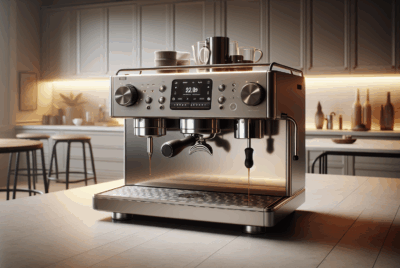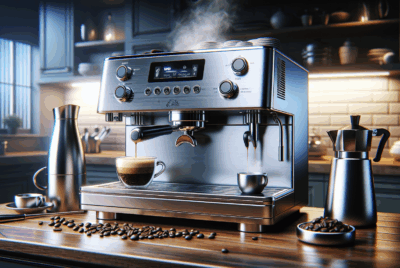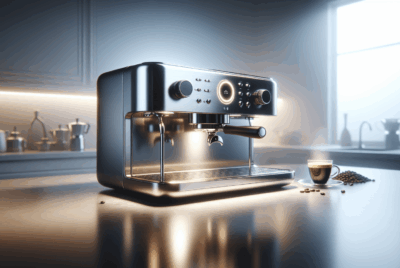Espresso Extraction Techniques: Mastering Flavor and Aroma
As an Amazon Associate, I earn from qualifying purchases, at no additional cost to you. Disclaimer
Making a great cup of espresso can feel like an art. The perfect balance of grind size, water temperature, and pressure can transform coffee beans into a rich, flavorful shot.
The key to successful espresso extraction is understanding these variables and how they interact.

When I pull an espresso shot, I focus on the grind size. A fine grind allows for the water to seep through slowly, extracting deep flavors.
Water temperature is another critical factor; too hot, and it burns the coffee, too cold, and it under-extracts.
Pressure helps push the water through the finely ground coffee, creating a beautiful crema on top.
Knowing how these techniques work can change your espresso game. With practice, anyone can master the art of espresso extraction.
The Essentials of Espresso
Espresso is a rich, concentrated coffee brewed by forcing hot water through finely-ground beans. Mastering its creation requires understanding extraction, the machine, and the choice of beans.
Understanding Espresso Extraction
Espresso extraction is key to a flavorful shot. It’s about the precise balance of water flow and pressure over the coffee grounds.
If the water passes too quickly, the shot can be weak and sour. If too slow, it can become bitter.
Optimal extraction time is typically around 25-30 seconds. This ensures a balance of acidity, sweetness, and bitterness. During extraction, the aim is to achieve a full-bodied taste profile.
Components of an Espresso Machine
An espresso machine is complex, with several vital components. The pump creates pressure, essential for extraction. The boiler heats the water to the right temperature, around 195°F (90°C). Consistent temperature is crucial for a quality shot.
The portafilter holds the coffee grounds while the steam wand froths milk. Each part must work in harmony. Understanding these components helps me identify faults and improve the espresso experience.
Role of Coffee Beans in Espresso Quality
The quality of coffee beans greatly affects the espresso shot. I always choose freshly roasted beans for the best flavor balance.
The beans’ origin, roasting level, and grind size all impact the shot’s taste.
Fresh coffee beans are full of aromas and flavors. Stale beans dull the espresso and diminish the drinking experience. In the coffee industry, investing in high-quality beans is seen as the foundation of a great cup.
Preparation Techniques
To make a good espresso, I look at how the coffee is ground, the amount used, and how it is tamped. These details help achieve a consistent and flavorful shot.
Grinding for Espresso
When I grind coffee for espresso, it’s important to focus on grind size and consistency.
I use a burr grinder because it gives a fine and even grind. Blade grinders are less ideal since they can produce uneven particles, which affects the flavor.
Consistent grind size is crucial for uniform extraction. If the grind is too coarse, the espresso can taste weak; too fine can make it bitter.
I always aim for a sand-like texture, which allows the best extraction during brewing.
Dosing and Tamping Basics
The dose of coffee I use is a key step in making high-quality espresso.
I typically use between 18 to 20 grams of coffee. It’s important to measure carefully for a balanced shot. I use a digital scale for precision.
After dosing, I move on to tamping.
I press the grounds evenly in the portafilter with steady, even pressure. Consistency in tamping leads to even water flow through the grounds. Uneven tamping can cause uneven extraction.
I always ensure a level surface to improve brewing results.
Pre-Infusion and Brewing
Pre-infusion improves the taste of espresso by wetting the grounds before full pressure is applied.
I usually allow water to flow gently at first, which avoids channeling. Channeling can lead to bitter or sour tastes.
In this step, I keep track of time and water temperature carefully.
The brewing time usually ranges from 25 to 30 seconds. I aim for water at about 200°F, as extreme temperatures can negatively impact the espresso flavor.
By managing these factors closely, I make sure each shot is rich and balanced.
Mastering Extraction

Creating the perfect cup of espresso requires precise control over several variables. The key is maintaining consistency and making informed adjustments. Understanding these factors helps in identifying and solving extraction issues efficiently.
Control and Consistency
Consistency is crucial when brewing espresso. I focus on keeping variables like pressure, temperature, and extraction time stable.
Using a reliable espresso machine helps ensure these factors remain constant during each shot.
Water temperature is particularly important. I aim for an ideal brewing temperature between 195°F and 205°F. This range promotes optimal extraction without bitterness.
I also regularly maintain my espresso machine. This includes descaling and cleaning to prevent malfunctions. Regular upkeep ensures consistent performance and helps me achieve the desired results every time.
Adjusting Variables for Extraction
Adjusting different factors allows me to refine the espresso’s taste. Tamping pressure affects the water flow through the coffee puck, influencing the extraction time. I find that applying around 30 pounds of pressure works best.
Water pressure and pressure profiling are also crucial. I keep them consistent to balance flavors in each cup. Small changes can have a big impact.
When adjusting variables, keeping records helps me track what works. By systematically changing one variable at a time, I gain better control over the results.
Identifying Extraction Issues
Recognizing signs of under-extraction and over-extraction is vital. Under-extracted espresso tastes sour, with a quick flow through the puck. Over-extraction, however, results in bitterness due to a slow pour.
By observing these signs, I can make necessary adjustments. Modifying the grind size, water temperature, or extraction time usually solves the problem.
Understanding these cues enables me to take corrective actions swiftly. Efficient troubleshooting ensures a consistently high-quality espresso experience, which is both satisfying and rewarding.
Espresso Shot Variations

Espresso shots can vary in size and strength, affecting the taste and experience. The Ristretto and Lungo are popular variations, each offering distinct flavor profiles and crema characteristics. Creating a balanced espresso involves careful attention to the brewing process, focusing on factors like acidity and flavor notes to achieve the perfect espresso shot.
The Ristretto and Lungo
In my experience, a Ristretto is a short shot of espresso. It uses the same amount of coffee but half the water. This results in a more concentrated and bold flavor. The taste is rich, with less bitterness and often more sweetness.
On the other hand, a Lungo is a longer shot. It uses twice the amount of water, extending the brew time. This produces a milder shot with a lighter body. The flavor notes may include a more pronounced bitterness due to the extended extraction.
These two variations appeal to different preferences. Ristretto suits those who like strong, intense flavors, while Lungo is great for a milder taste. Both play with the acidity and crema differently, creating unique coffee experiences.
Creating a Balanced Espresso
Achieving a balanced espresso is all about the right combination of factors. I focus on using the right grind size, which affects the crema and flavor notes.
The espresso brewing process is critical, paying attention to the water temperature and extraction time.
To me, a perfect espresso shot has subtle acidity, a strong aroma, and a pleasing flavor profile. It’s crucial to adjust these elements to improve balance.
When I make espresso, I often experiment with slight changes to reach the desired taste.
Balancing each component ensures that the espresso is neither too bitter nor too sour. Mastering this art leads to an exceptional coffee beverage, with harmony in every sip.
Advanced Techniques and Maintenance

In exploring advanced espresso techniques, I focus on methods like precise shot timing and achieving optimal grind consistency. Maintaining espresso machines is key for peak performance, ensuring good water quality and preventing blockages.
Beyond Basic Brewing
To enhance flavor profiles, I experiment with brew time and the coffee-to-water ratio. These elements can greatly affect the taste.
For richer espresso, I often adjust the brew ratio, aiming for the perfect balance. Pump pressure is crucial, too; I usually set it between 8 and 10 bars for better extraction.
When espresso preparation is done correctly, it results in smooth and flavorful coffee.
Shot timing is important, and I usually aim for about 25 to 30 seconds to perfect the espresso’s taste. I also give attention to steaming milk, aiming for a velvety texture for lattes or cappuccinos.
Maintaining Equipment for Optimal Performance
Regular maintenance is critical for automatic machines.
I make it a habit to clean them daily to preserve grind consistency. A clean grinder ensures that each shot is as fresh as possible.
Ensuring proper water quality is another important step. I often use filters to reduce mineral deposits.
Cleaning cycles should be performed weekly. This helps prevent clogs and maintains extraction times.
Taking apart your machine to check for wear and build-up also ensures longevity. Proper maintenance guarantees that every cup of espresso I make is consistent and enjoyable.
Frequently Asked Questions

I’ve gathered some key details on how various factors influence espresso extraction. These include water pressure, ratios, and other essential elements that can impact your coffee.
How does the espresso extraction ratio affect the quality of the shot?
The espresso extraction ratio is the amount of coffee used compared to the amount of water. A proper balance can improve flavor, strength, and aroma.
If you use too much water, the shot might taste weak. Using too little water can make the espresso taste too bitter or strong.
What are the optimal extraction times for different espresso blends?
Different blends have unique characteristics, and the best extraction time can vary.
For a medium roast, I aim for about 25-30 seconds. Dark roasts may require a shorter time to avoid a burnt flavor. Light roasts can take a bit longer to emphasize fruity or floral notes.
What role does water pressure play in extracting a perfect espresso shot?
Water pressure, typically around 9 bars, is crucial for forcing water through the coffee grounds.
It extracts flavors and oils that give espresso its rich taste and crema. If the pressure is too low, the coffee might taste sour. High pressure can make it taste bitter.
Can you explain the stages of a proper espresso extraction?
Espresso extraction involves three main stages: pre-infusion, ramp-up, and steady state.
Pre-infusion wets the grounds and helps even extraction.
The ramp-up is when pressure builds to full strength.
The steady state is where most of the extraction happens, giving you a balanced shot.
How can I use an extraction chart to improve my espresso shots?
An extraction chart helps me see how time, temperature, and grind size affect espresso.
By plotting these factors, I can adjust each one to achieve the ideal taste.
The goal is usually a balanced sweet, sour, and bitter profile that suits your personal preference.
What adjustments should be made for espresso extraction in different brewing conditions?
Different conditions like altitude, humidity, and temperature can affect espresso quality.
At higher altitudes, water boils at a lower temperature, so I might need to adjust the brewing temperature.
Humidity can impact how coffee absorbs water, requiring changes to the grind size or extraction time.



